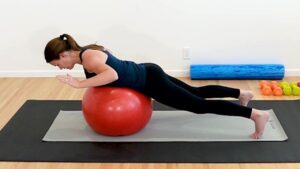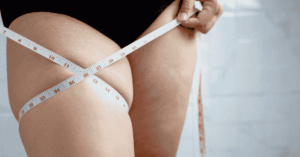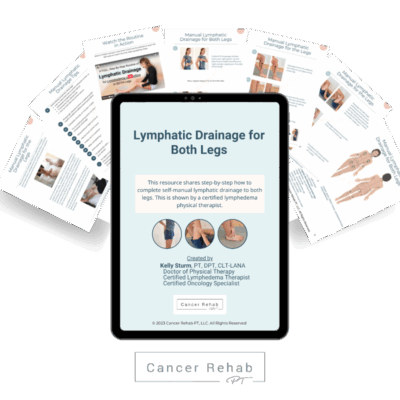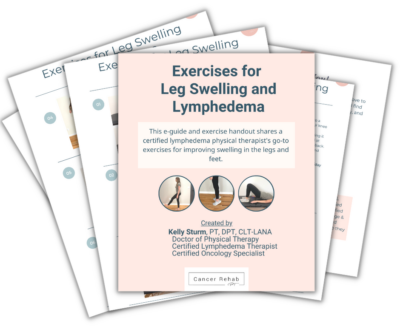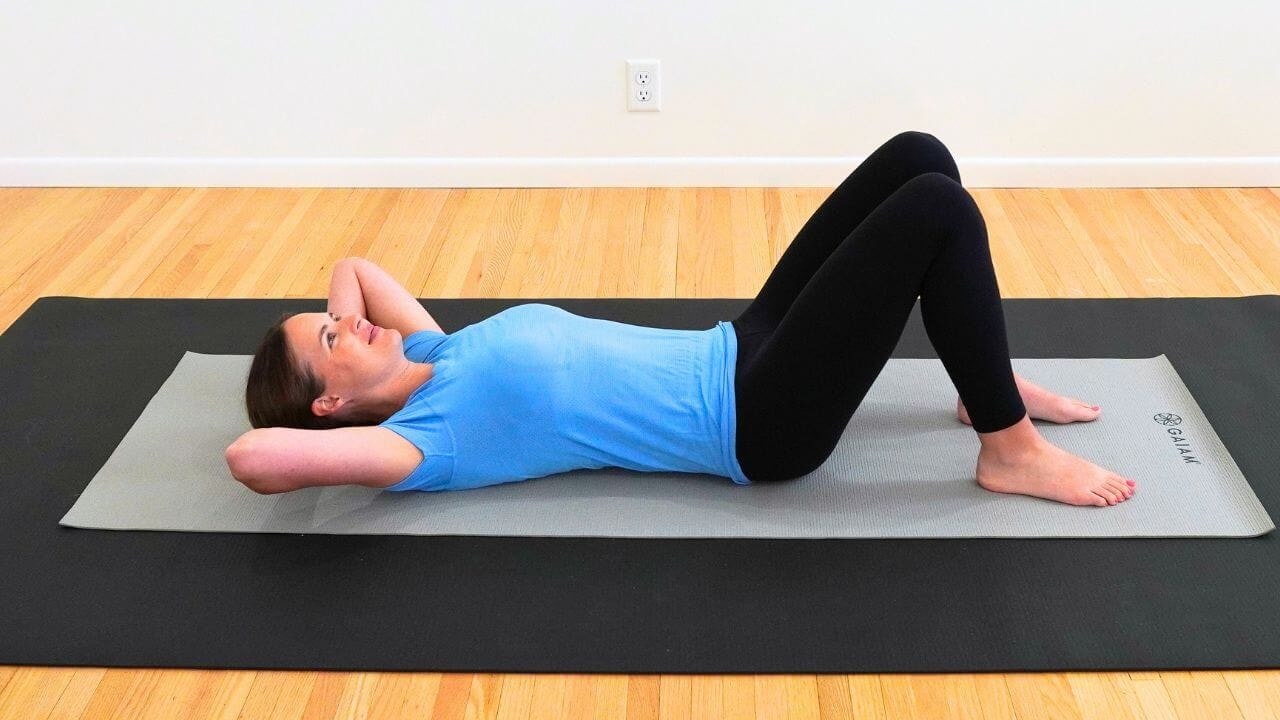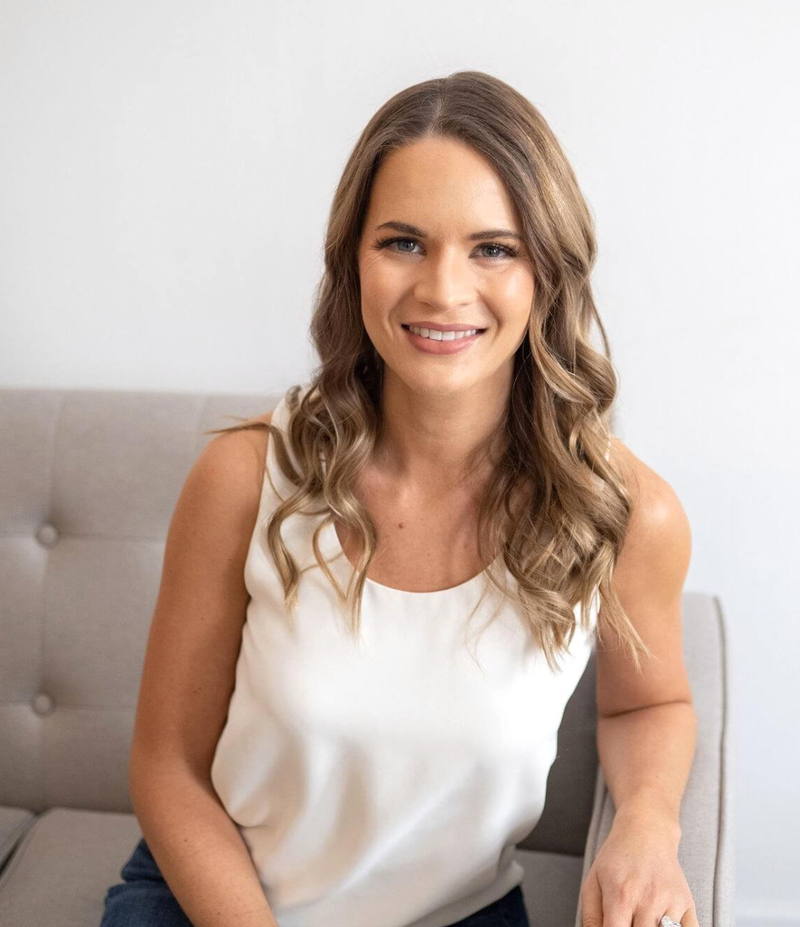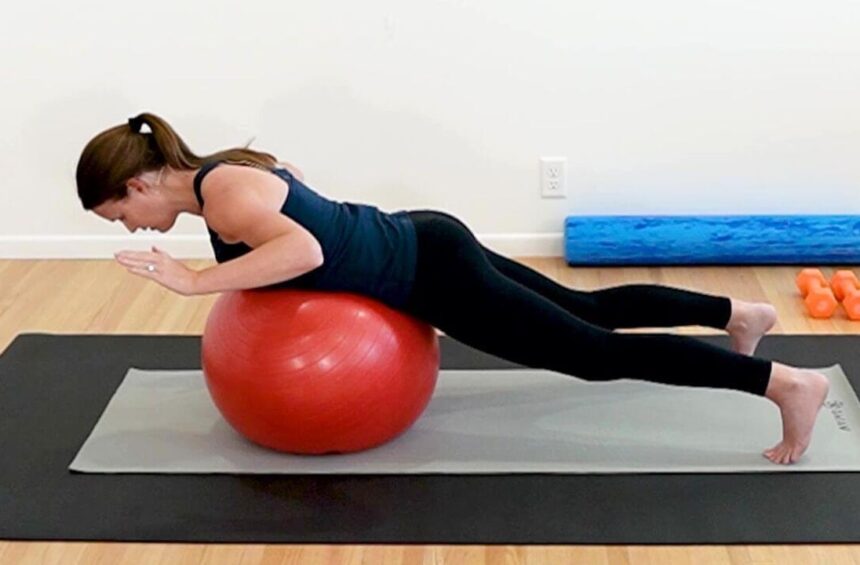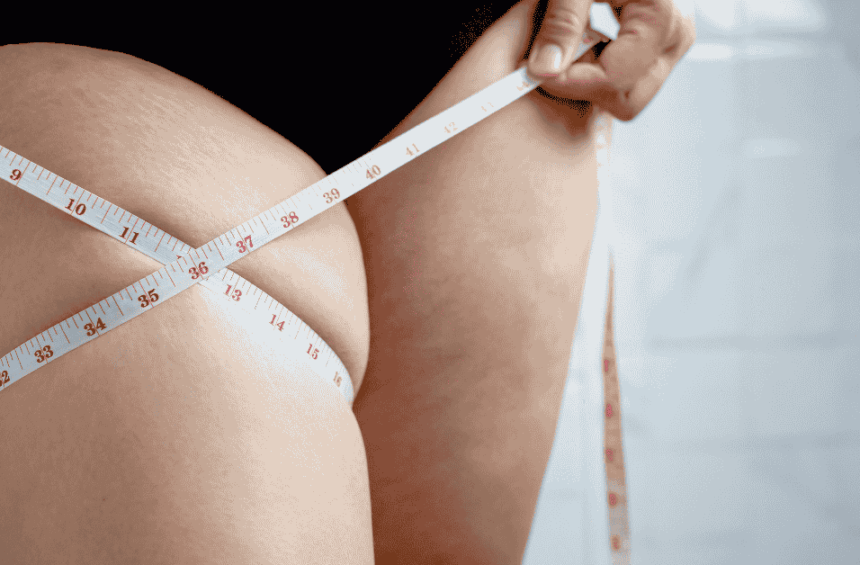Recovering from breast cancer surgery can feel overwhelming, especially in those first couple of weeks, but early exercises after breast cancer surgery can help ease discomfort and reduce swelling.
My name is Kelly, and I am a certified oncology and lymphedema therapist. I specialize in working with patients recovering from breast cancer or those with lymphedema.
These exercises are part of an early recovery series, targeting the initial 0-3 weeks after surgery. Because everyone has a different surgery and recovery experience, these exercises should only be done if someone is cleared by their doctor first for safety.
Looking for next steps? Download my free Breast Recovery Roadmap for all 8 phases.
Why You Should Exercise After Breast Surgery
Beginning exercise after surgery, when you are cleared by your doctor to do so, is beneficial in helping someone regain full movement in their arms and shoulders and resume normal daily activities. The American Cancer Society recommends exercise to reduce the side effects of breast cancer surgery.
What Is the Best Exercise After Breast Cancer Surgery?
A mastectomy is a major surgery, and understanding the recovery process can help you feel empowered in your healing journey as you resume daily activities in the healthiest way possible. The recovery time for someone after a mastectomy can range from 3-12 weeks and depends on whether the person has had breast reconstruction or not.
There is no best exercise or one-size-fits-all approach when it comes to starting exercises after breast cancer surgery. However, these are gentle early exercises for the first 0-3 weeks that I recommend to help someone ease into movement, and help reduce pain and swelling.
If you are looking for additional shoulder or arm exercises after breast surgery, visit my blog post Exercise After Mastectomy: Guide From a Physical Therapist.
Early Exercises After Breast Cancer Surgery (0-3 Weeks)
This guide walks you through 3 exercises for those who have drains in place and then 3 for those who don’t have drains, or who have had them removed. All exercises should remain mild without significant pain or strain.
These exercises work for both mastectomy and lumpectomy. There are now more women in the US choosing mastectomy over lumpectomy for early-stage cancer, according to BreastCancer.Org. For a more detailed review of the differences between a mastectomy and lumpectomy, see my blog post Lumpectomy vs. Mastectomy: Making Your Decision.
Everyone’s recovery experience is different. Prior to beginning these exercises, one should speak with their healthcare provider to get safety clearance.
If you would like to follow along with a video of a certified physical therapist modeling these exercises, you can watch the YouTube video linked below.
Exercise Details
These basic exercises are done standing, lying down, and in a sitting position. These early exercises are for the first 0-3 weeks after surgery and focus on arm and shoulder movement.
Equipment Required
- A small ball or hand towel
- A dowel, such as a PVC pipe or a light golf club
- A chair and a countertop or table
When Drains Are in Place
If you are someone who still has drains in place, gentle exercise helps increase movement; however, you don’t want to raise your hands above shoulder height. You want to make sure you keep your arms by your sides to ensure there is safety with your drains.
Biceps Curls
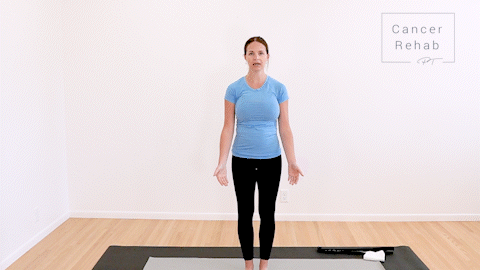
We are going to begin with gentle arm movement to help get our blood flowing. For these bicep curls, we won’t be using any weight.
- Begin standing in a neutral position with your arms relaxed at your sides.
- Keep your elbows tucked near your sides.
- Bend your elbows up and then slowly lower straight back down.
- Keep your upper body and shoulders in place, and just focus on moving your arms.
- Repeat 8 to 10 times.
Towel or Ball Squeezes
For this exercise, you will need a small ball, such as a tennis ball, or even a small hand towel that you can roll up. With this arm exercise, you are focusing on muscle activation in your lower arms and hands, and keeping circulation moving. You don’t want to squeeze to the point where you are feeling any pain.
- Stand with your shoulders relaxed and your elbow by your side at a 90-degree angle.
- Gently squeeze into the towel, or your ball, and relax.
- Repeat 8 to 10 times and then switch to the other arm.
Lying Down Shoulder Abduction
You will begin lying down on your back with your feet slightly apart and your knees bent. If someone isn’t comfortable lying completely down, fully on their back, this can be done in a recliner.
- Begin lying on your back, allowing gravity to help your shoulders release and take tension off your posture.
- Gently start to slowly slide your arms out to your sides, 45 degrees at most, and then bring them back down to your sides.
- Focus on getting a small amount of motion within the shoulders, but staying within proper range for your drains.
- Repeat 8 to 10 times.
Focus on slow movements that allow for motion within your shoulders and the opening of the chest. The goal is that gravity is letting you release tension and get a gentle stretch, but one should not feel pain.
When Drains Are Out
Next, we are going to move on to exercises for someone who has their drains out or who doesn’t have drains early on. For these exercises, you will need a very light dowel, such as a PVC pipe or a light golf club.
These exercises are done lying down and sitting; however, if someone isn’t comfortable being fully on their back, they can be done in a reclined position.
Dowel Shoulder Raises
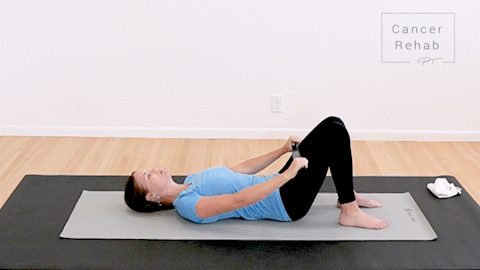
- Begin lying on your back in a comfortable position with your feet propped up.
- Next, you will hold onto the dowel with both hands and raise your arms up over your chest and above your head until you feel a gentle stretch. You don’t want to feel pain, so this may be a small motion for some.
- Repeat 8 to 10 times.
Dowel Shoulder Raises – Single Arm Alternative
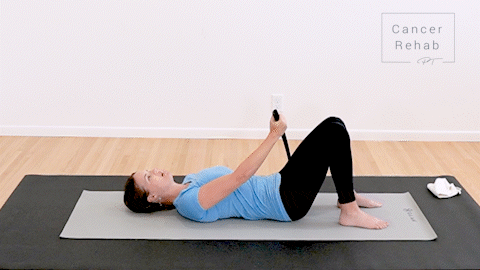
If this motion using both hands is uncomfortable, someone can do one arm at a time.
- Begin in the same position with one hand on top of the dowel and the other on the bottom as a guide.
- Use your bottom hand to gently guide the dowel up until you feel a mild stretch.
- Complete 8 to 10 times and then switch to the opposite side.
Butterfly Chest Stretch
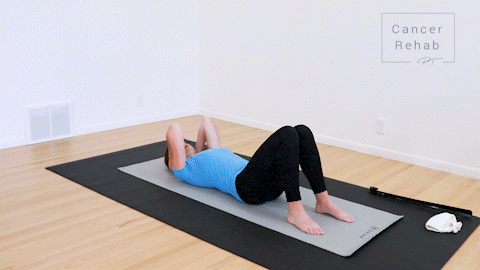
For this next exercise, we are going to begin lying on our backs and work on our postural tightness around the chest.
- In this position, gently put your hands behind your head with elbows bent. Point your elbows up towards the ceiling. If this is not comfortable, don’t force it! You can have your elbows by your sides.
- Gently let your elbows fall open to the sides, just to the point where you feel a mild stretch across your chest.
- Hold there briefly and then come back to the starting position.
- As you get more comfortable, your next goal would be to hold for 3 to 5 seconds and take a single inhale and exhale as you hold, feeling your ribcage expand and sinking deeper into the stretch.
Table Slides
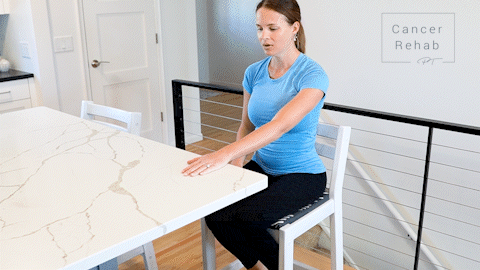
This is another great shoulder exercise after breast cancer surgery, to help get movement in the side of the body and motion in your shoulder.
- Begin sitting on a chair with a good distance between you and the table or the countertop.
- Start with one hand at a time. Sit up nice and tall, relax your shoulders, and let your hand rest at the table with your elbow straight.
- Hinge from your hips as you learn forward to reach across the table, keeping your arm nice and relaxed. Reach as far as you feel comfortable to get a mild to moderate stretch.
- Sit back up with your body returning to your starting position.
- Repeat 8 to 10 times and then repeat with the other arm.
Breast Cancer Treatment Recovery: What to Expect
Breast cancer treatment recovery is emotionally and physically challenging, and can be different for everyone. As a Doctor of Physical Therapy and Board Certified Oncology Therapist, I work with patients who are regaining normal movement in their arms and shoulders, and those who have breast cancer-related lymphedema. Beginning breast cancer rehabilitation can help someone return to their daily activities and resume a normal quality of life.
If you are dealing with swelling, you may benefit from Breast Cancer Rehab, my self-paced online course that helps those recovering from breast cancer minimize pain, build up strength, and improve their quality of life.
FAQs
How long does it take to fully heal from breast cancer surgery?
The time it takes to fully heal from breast cancer surgery can look different for everyone; however, generally, it can take anywhere from 3 to 12 weeks. For those who haven’t had reconstruction, their recovery time may be anywhere from 3 to 8 weeks, while those who have had reconstruction can expect a longer recovery period of 8 to 12 weeks.
How long to wait to exercise after breast cancer surgery?
It is generally recommended that one wait at least 4 to 6 weeks after surgery before beginning light exercise. This is completely dependent on one’s individual recovery process, and it’s best that someone speaks with their healthcare provider or surgeon to get safety clearance before resuming physical activity.
When can you lift arms overhead after a mastectomy?
It is advised that one does not lift their arms overhead after a mastectomy until cleared by their doctor or surgeon to do so, especially if they have had reconstruction or have drains in place.
Final Thoughts
Feeling like yourself again after breast cancer surgery is possible. After receiving clearance from your doctor, begin with gentle physical activity to help regain normal movement and resume your usual activities.

